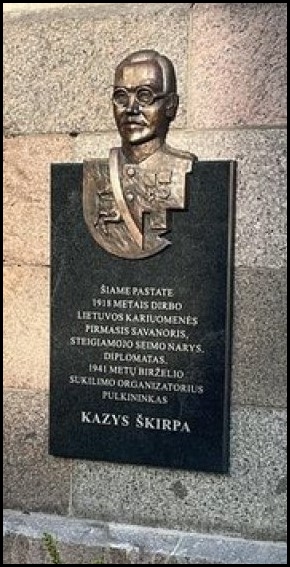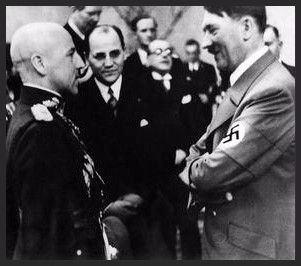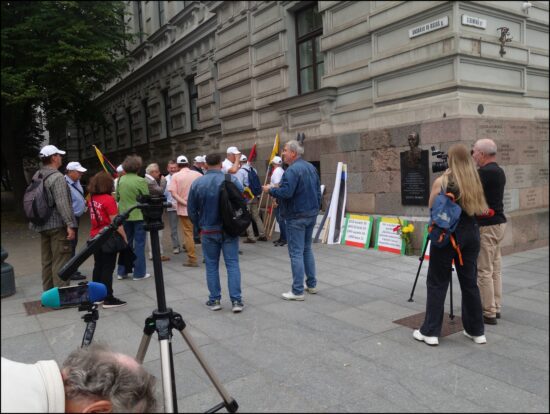OPINION | COLLABORATORS GLORIFIED | KAZYS ŠKIRPA | GENOCIDE CENTER IN VILNIUS | GENOCIDE MUSEUM | SHRINES TO HOLOCAUST COLLABORATORS IN VILNIUS | VILNIUS
◊

Brand new plaque in central Vilnius for the man who set the formal goal of eliminating Jews from Lithuania in the run-up to the onset of the Lithuanian Holocaust. Photo: DefendingHistory.com
◊
by Dovid Katz
VILNIUS—A crowd of ultranationalist glorifiers of Hitler’s invasion of Lithuania in June 1941 today affixed a handsome new plaque (with bas relief) on the corner of Vilnius’s central boulevard, glorifying Kazys Škirpa, who wrote pamphlets, in Berlin, calling for the elimination of Jews from Lithuania. His writings and radio broadcasts help incite the onset of the Lithuanian Holocaust on 23 June 1941, when his followers began butchering Jewish neighbors in Kaunas, and across Lithuania, before the Germans even arrived.
“The Lithuanian diplomat Kazys Škirpa used this suffering in his radio broadcasts to spur mobs to murder.”
—Timothy Snyder, in Bloodlands (2010, p. 192)
Since the United States ambassador to Lithuania, HE Kara McDonald, said for the record earlier this year that glorification of Holocaust collaborators is “part of the definition of antisemitism,” attention has been focused on the two collaborators she cited by name, Jonas Noreika and Juozas Krikštaponis, and especially on Noreika. American journalist Lev Golinkin has initiated an inventory of public shrines to Nazi collaborators in Lithuania. While honoring Vilna’s 700th birthday last year, Defending History renewed its calls for removal of all shrines to Hitler’s collaborators in modern Lithuania’s beautiful capital.
The Noreika Plaque on the facade of the Library of the Academic of Sciences, a minute’s walk from Cathedral Square, was taken down “temporarily, for repairs” last year in the run-up to the July 2023 NATO conference. Defending History has been updating readers on the latest stage of the “repairs” underway. With eyes on Noreika near the “bottom” of Gedimino Boulevard, Vilnius’s beloved central thoroughfare, a brand new shiny plaque has gone up near the “top” of Gedimino, on the wall of Vilnius District Court, part of the block also housing the city’s Genocide Museum (recently renamed “Museum of Occupations and Freedom Fights” after a long Defending History campaign on abuse of the word “genocide” to diminish the Holocaust that wiped out 96% of Lithuanian Jewry).

Škirpa (in Berlin) is in the middle. Archive photo in the public domain.
The new plaque, decorating the court of law’s outside wall, honors Kazys Škirpa, who did not personally kill a single Lithuanian Jew. He was the Hitlerist “ambassador” of an aberration of the proud prewar Lithuanian state, who was urging the total elimination of Jews from Lithuania in his writings and pamphlets in the months leading up to the Nazi invasion of 22 June 1941. So “successful” was Škirpa that his writings and radio addresses helped rev up local Lithuanian fascists who put on a white armband (the “white-armbanders”) and went on to butcher thousands of Lithuanian Jews before the Germans arrived or before they set up their administration during the final week of June 1941. In many hundreds of interviews with Lithuanian Holocaust survivors, there was universal agreement that the Holocaust here was initiated on 23 June 1941. That was for the last generation of Litvaks here the black day when six centuries of proud tolerance was transformed by bands of racism-drunk “freedom fighters” whose rampage of murder, pillage and humiliation was a big part of what is arguably the most brutal betrayal of neighbors in human history.
Attempts to “fake the history” call the slaughter of Jews “an uprising against the Soviets,” an historical nonsense. While the Soviets were in control, Škirpa’s followers in Lithuania scarcely shot a single rabbit. When the Soviets were fleeing in disarray from Hitler’s Operation Barbarossa, his “white-armbanders” started a butchery that shocked even the arriving German forces who rapidly initiated the “orderly” annihilation of close to all the Jewish population to replace such scenes as rabbis’ heads hanging from a bridge (in Kaunas/Kóvne), teenaged girls cut in half (in Shavl/Šiauliai), and an assortment of barbaric acts against defenseless fellow citizens. History is full of atrocities by so many. The issue today is glorification of perpetrators in the public space of a modern democracy.
Excerpts from leaflets emanating from Škirpa’s offices in Berlin
The plaque affixed today reads in translation: “Colonel Kazys Škirpa, the first volunteer of the Lithuanian Armed Forces, Member of the Constituent Assembly, diplomat, and organizer of the 1941 June Uprising, worked in this building in 1918.” But there was no June Uprising. An uprising is something rising against those in powers, not a massacre of innocent neighbors as Soviet forces were fleeing not them, but the German invasion — the largest invasion in human history. For Vilnius’s Holocaust survivors, one of the greatest source of pain was the continued naming of a Vilnius street for 23 June 1941, the day that was for all of them the start of the Lithuanian Holocaust. What European capital would want to celebrate that?
According to Lithuanian media reports last night, the new Škirpa plaque was affixed “without coordination,” the same lame excuse used in 2019 when a new Noreika plaque was affixed after the then mayor had the old one taken down.
After years of campaigning by Defending History and numerous others, Škirpa Street was renamed in 2019, though the single new street name sign, translating “Tricolor Street” (aptly honoring the Lithuanian flag) was rapidly “adorned” with a plaque honoring the chief local “theoretician” of the Lithuanian Holocaust. The saga can be followed in Defending History’s Škirpa section.
The Defending History community calls on President Gitanas Nausėda, Prime Minister Ingrida Šimonytė, and Vilnius’s Mayor Valdas Benkunskas to have the plaque removed immediately as simple matters of law and order (the rule of democracy over the mob’s ability to affix at will permanent plaques glorifying Holocaust collaborators in the public space in the middle of a nation’s proud capital), and a firm statement to the proud community of European Union and NATO nations that glorification of perpetrators, collaborators and inspirers of the Holocaust will never again be tolerated in the public space.
Already today, groups of worshippers of Hitler’s invasion of 23 June were beginning to come with placards and flowers. The grave insult against Lithuania’s grand history is ironically symbolized by the corner of the two streets named for Grand Duke Gediminas, the multiculturalist founder of Vilna some 701 years ago, and the street named for the 16th of February 1918, date of the rise of the interwar democratic republic of Lithuania, whose 100th anniversary, in 2018, this journal marked via launch of a modest virtual mini museum of Jewish life in interwar Lithuania. How this magnificent past is so wantonly trashed by a plaque to a Hitlerist advocate of ethnic cleansing that would soon come true in the most extreme case of genocide in human history.

Groups start to gather paying homage to Hitler’s invasion of Lithuania and the gentleman whose pamphlets and radio addresses incited thousands to start murdering Jewish neighbors before German forces arrived. Photo: DefendingHistory.com
See also DH’s Škirpa section, and:
Milan Chersonski, “A ‘Documentary Film’ Tries to Establish the Legend of the ‘Uprising of the Enslaved’” in Defending History, 24 July 2011.
Andrius Kulikauskas, “Documents Which Argue for Ethnic Cleansing (by Kazys Škirpa, Stasys Raštikis, Stasys Lozoraitis and Petras Klimas in 1940-1941 and by Birutė Teresė Burauskaitė in 2015)” in Defending History, 18 Dec. 2015.
Andrius Kulikauskas, “Mažvydas National Library Wants Us to Listen to Valiušaitis, a Denier of Škirpa’s Atrocities” in Defending History, 10 Feb. 2018.
Defending History (news item), “Vilnius City Council Finally Decides to Change Name of Škirpa Street” in Defending History, 24 July 2019.
Excerpts (in English translation) from Škirpa’s own memoir later claiming that his real purpose was expulsion rather than genocide. But in numerous Lithuanian towns, LAF white-armbanders blocked the roadways to prevent Jewish citizens from escaping eastward on 22, 23 and 24 June 1941.
Eyewitnesses testimonies (video excerpts) of the rampage of murder, pillage and humiliation inflicted on Lithuania’s Jewish citizens by the Škirpa-inspired LAF in the week of 22 June 1941.